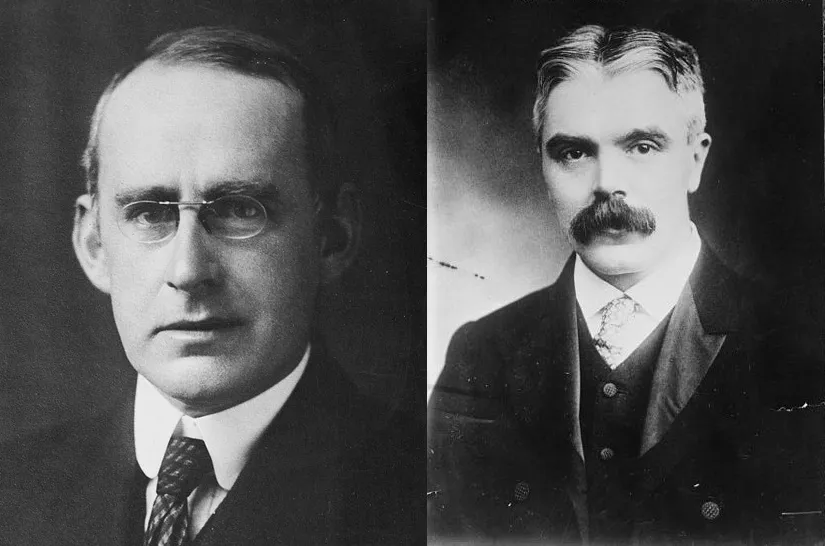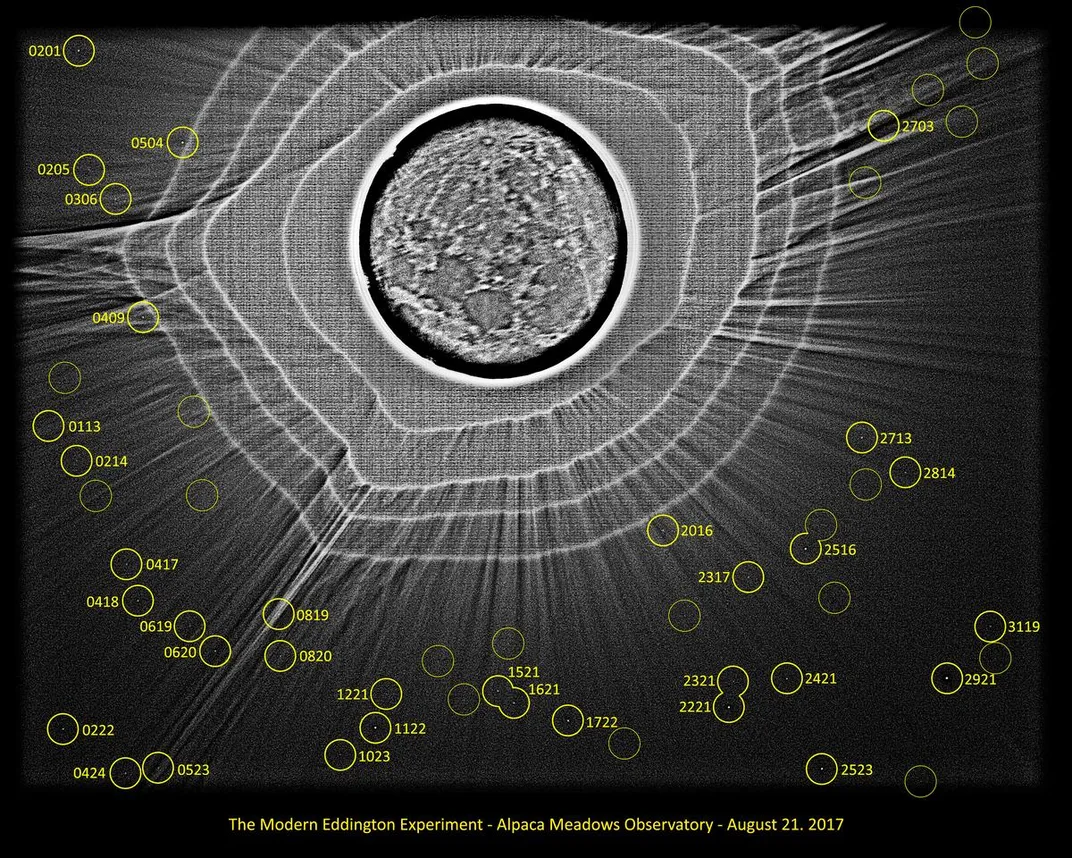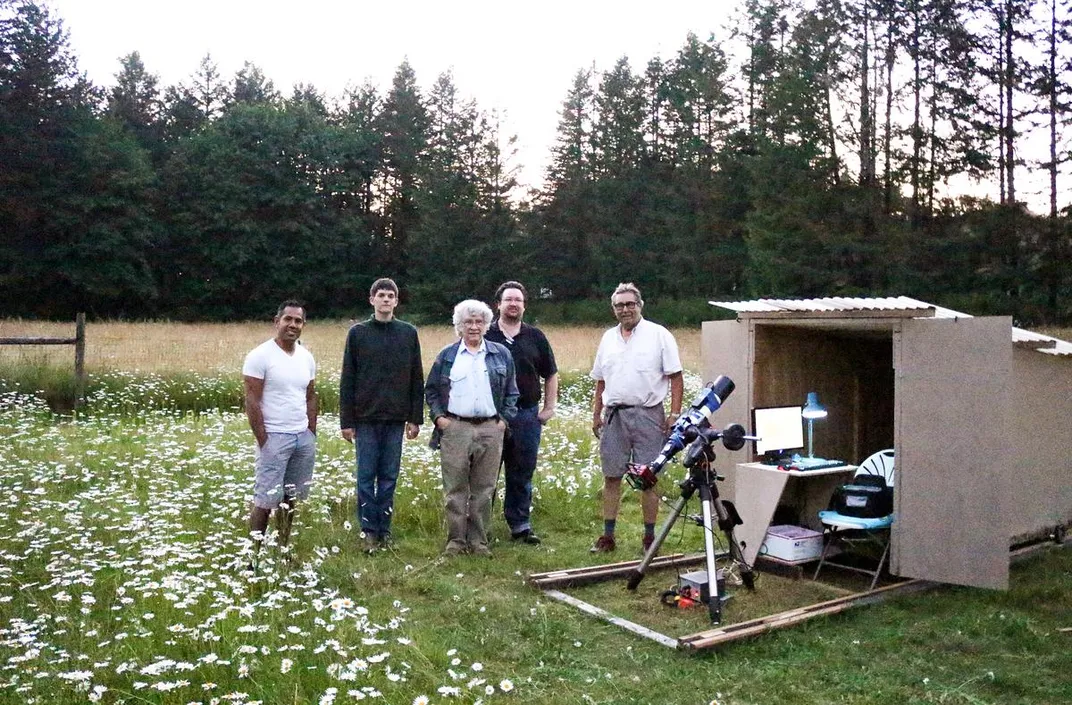A Total Solar Eclipse 100 Years Ago Proved Einstein’s General Relativity
Two teams of astronomers voyaged to Africa and Brazil to observe the most famous eclipse in science
:focal(600x394:601x395)/https://tf-cmsv2-smithsonianmag-media.s3.amazonaws.com/filer/02/e5/02e547d3-6748-46f5-83b8-16a5a8951399/ezgifcom-resize_11.jpg)
As the morning sky darkened over western Oregon, Richard Berry’s three alpacas retreated into their barn. The dimming daylight and small crowd that had gathered at Berry farm—flocks of out-of-towners with cardboard solar glasses and quadcopter drones—stressed out the animals. Meanwhile, the moon and sun were performing a rare celestial ballet above their heads.
On August 21, 2017, the first total solar eclipse to grace both coasts of the continental United States in 99 years was underway. But Berry, an amateur astronomer and former editor-in-chief of Astronomy magazine, and a group of students from Portland Community College weren’t just there to enjoy the view. They had prepared their telescopes and camera equipment to repeat the most famous eclipse experiment of all time, the first successful test of Albert Einstein’s general theory of relativity. Almost one hundred years before the Great American Eclipse, two teams of astronomers ventured to distant shores to observe an eclipse that would convince a skeptical world that Isaac Newton’s theories of gravity were wrong.
One consequence of Einstein’s theory, first published in 1915, it is that massive celestial objects, like the sun, bend the fabric of spacetime around themselves—which is how Einstein explained the pull of gravity. This astrophysics theory is very different from Newton’s idea of gravity as an attractive force exerted by all matter. According to Einstein, any light traveling in the vicinity of a massive object is bent along with spacetime. In the early 20th century, Einstein came up with a way to demonstrate this seemingly preposterous theory using a total solar eclipse.
Einstein laid out the challenge as follows: Chart the positions of stars around the sun during totality, those precious moments when the sun’s direct light is totally blocked by the moon, allowing the stars in the background to be seen. And, observe the same stars when there is no eclipse. If his theory of general relatively was indeed correct, there would be a slight difference in the positions of those stars—a change invisible to the human eye, but detectable through fine measurement.
In 1919, English astronomers Arthur Eddington and Frank Dyson organized expeditions to the island of Principe off the west coast of Africa and to Sobral, Brazil, respectively, to see if Einstein was right. The fateful day was May 29. Once they publicized their results, the world would never be the same—or at least, our understanding of it.

In 2017, Toby Dittrich, a physics professor at Portland Community College, coordinated a dozen observing groups including Berry’s, sending two of his students to the alpaca farm and others to an Oregon mountain to see if they could do at least as well as Eddington and Dyson.
Both efforts had to contend with technical challenges and the fickleness of weather, knowing the window of opportunity for observing totality would be fleeting.
In 1919, astronomers had the distinct luxury of more than five minutes of totality. In 2017, the total eclipse phase lasted only about two minutes for American viewers. Passing clouds or wind could ruin the observations in those precious moments—in fact, cloud cover ruined a relativity test during the U.S. total solar eclipse of 1918.
Don Bruns, an amateur astronomer stationed in Casper, Wyoming for the 2017 eclipse and coordinating with Dittrich’s effort, was partly inspired by four failed attempts to replicate the Eddington-Dyson experiment between 1936 and 1954.
“By doing this, I kind of let the astronomers rest in peace,” Bruns says.
**********
Eddington and Dyson’s respective expertise made them well suited to this eclipse-chasing task. Dyson was England’s Astronomer Royal and directed the Royal Observatory at Greenwich. Eddington directed the Cambridge Observatory, and he also made a name for himself in the realm of theory for showing that the sun is able to exist as we know it, rather than collapsing under its own weight, because light itself exerts an outward pressure.
/https://tf-cmsv2-smithsonianmag-media.s3.amazonaws.com/filer/9b/d9/9bd9d107-b1f5-4768-949c-b4f8ef4b4eaa/berry3.jpg)
The Principe effort, stationed at a cocoa planation in the northwest part of the African island, was carried out by Eddington and Edwin Cottingham. The duo used mostly borrowed equipment from Oxford Observatory, since Eddington’s own Cambridge Observatory was not specialized for eclipses, according to Daniel Kennefick’s new book, No Shadow of a Doubt: The 1919 Eclipse That Confirmed Einstein’s Theory of Relativity.
Eddington likely did all of the data analysis from his expedition personally, although no records survive that he made during his journey—not even the original photographic plates, which have gone missing over time. According to the firsthand account of astrophysicist Subrahmanyan Chandrasekhar, Dyson told Cottingham that if Eddington observed an amount of deflection twice as great as what Einstein predicted—a bizarre result that neither Einstein nor Newton’s framework would anticipate—“Eddington will go mad, and you will have to come home alone.”
Meanwhile, Dyson did not actually leave England for the occasion. To Sobral, Brazil, he sent two members of his staff, Charles Davidson and Andrew Crommelin, and some equipment from his observatory. When they returned, Dyson directed the analysis of the team’s data and collaborated with Eddington on the final report.
Each of the 1919 teams needed to return with two critical pieces of data encoded on glass plates. At least one plate would be taken during totality, while the other was made at night with the same stars in the sky, but no sun and moon in the foreground. Even if this were done well, the person analyzing the plates would have a real challenge.
“The stars, of course, looked like little circles on the plates,” Kennefick says. “It turns out that the change in the position is actually less than the size of the circle. So it’s a very, very fine measurement to make. It’s a very difficult measurement to make.”
Fortunately, Dyson made his living making these kinds of observations. His normal work involved careful studies of stellar positions and examining small changes. He used a small device called a micrometer screw, which moved across the plate from one point to the next and measured the distance between objects.
They were in luck on the day of the 1919 eclipse because the sun was near a very bright cluster of stars called the Hyades, which Eddington called “by far the best starfield encountered.” Their brightness would make them easier to spot on a telescope plate than fainter stars, which could be lost in the glare of the outer region of the sun’s atmosphere, called the corona. (This superheated plasma is only visible to the naked eye during a total solar eclipse, when it appears to shimmer around the blotted-out sun.)
/https://tf-cmsv2-smithsonianmag-media.s3.amazonaws.com/filer/aa/93/aa931c5f-453b-4a85-ad55-5a6a9c4eb63c/ezgifcom-resize_12.jpg)
Though the two-pronged experiment proved successful, both getting close to Einstein’s prediction for the amount of deflection, it was not without controversy. One of the two telescopes in the Sobral expedition produced dubious-looking plates, with stars that looked more like smudges than circles. Dyson appears to have made the call to throw the data out, and some historians wonder if the Eddington-Dyson group was so hopeful to prove Einstein right that they improperly threw out data that didn’t agree.
But Kennefick says it’s unlikely Dyson fudged the results. Eddington was the scientist who vocally supported Einstein’s predictions before the experiment took place, and he had nothing to do with tossing Sobral plates.
“It is rare to be completely neutral in science or life,” Kennefick writes. “Punishing Eddington for being honest in articulating his preferences is merely asking that scientists dishonestly suppress their views.”
**********
Einstein didn’t seem overly concerned that his then-niche theory would finally be put to the test. Some have even suggested that he was smug about the whole ordeal, so sure of his theory that he wasn’t the least bit nervous about what the 1919 expeditions would find.
“Famous scientists said to him, ‘I can’t really believe how calm you were about this,’” Kennefick says. “They were like, ‘Oh my God, this is incredible.’ And he was saying, ‘Yeah, I knew.”
/https://tf-cmsv2-smithsonianmag-media.s3.amazonaws.com/filer/d8/76/d876169c-9261-47e4-ba33-31e044e96bc0/ezgifcom-resize_15.jpg)
But despite Einstein’s lack of doubt, he wanted the experiment to be carried out. As early as 1911 he had written to other astronomers asking if they could do this kind of eclipse experiment, and he actively raised money for the cause. He financed German astronomer Erwin Freundlich’s expedition to Crimea in 1914 to do the eclipse observations Eddington would eventually make, but Freundlich’s journey suffered an ill-fate. Archduke Franz Ferdinand was assassinated while Freundlich was crossing Russia, World War I broke out, and the astronomer was arrested by the Tsar’s men, his equipment confiscated.
**********
The physicist and philosopher Ilse Rosenthal-Schneider was allegedly with Einstein just after he received a telegram in September 1919 with news that the Eddington-Dyson experiment confirmed his predictions. She wrote that Einstein seemed happy but not ecstatic, and his lack of enthusiasm surprised her.
“So, she said, ‘Well, what would you have said if the theory had found against you? Would you have been disappointed, in that event?’” Kennefick says. “And [Einstein] smiled and said, ‘Well then I would have been sorry for the dear lord, because the theory is correct.’”
The results were formally presented at the Royal Society meeting in London on November 6, 1919, propelling Einstein to world fame. According to the account of mathematician Alfred North Whitehead: “The whole atmosphere of tense interest was exactly that of the Greek drama: We were the chorus commenting on the decree of destiny as disclosed in the development of a supreme incident. There was dramatic quality in the very staging—the traditional ceremonial, and in the background the picture of Newton to remind us that the greatest of ceremonial generalizations was now, after more than two centuries, to receive its first modification.”

There was, however, another solar eclipse in 1922, giving others a chance to corroborate Eddington and Dyson’s results. But naturally, in 1919, astronomers “got excited. They were happy. They were energized. But they did appreciate [they could] check it in three years,” Kennefick says. “There’s no point in putting the champagne on ice for three years.”
For that 1922 eclipse, a group from California’s Lick Observatory did a follow-up experiment and got results that closely aligned with Eddington and Dyson’s, but by then, Einstein was already well celebrated. (Dyson also tried repeating the experiment, but his view was clouded out.)
**********
No professional efforts have tried replicating the Eddington-Dyson experiment since 1973, as eclipses are no longer necessary for measuring the sun’s light deflection that Einstein predicted. Radio telescopes, for example, allowed scientists in the 1970s to observe the sun bending light from quasars—super-bright galactic cores, each consisting of a giant black hole surrounded by a disk that emits enormous amounts of energy—during the daytime without the help of an eclipse.
Most of the dozen amateur groups Dittrich coordinated in 2017 to repeat the early 20th-century version of the eclipse experiment learned just how many ways a single run of an experiment can fall through. At ten of the sites, participants had problems with their equipment, such as power supply and overexposure, or atmospheric turbulence, and they didn’t get usable data. One group accidentally kicked the telescope’s tripod at a critical moment. These blunders underscore how lucky both 1919 expeditions were to have captured any usable stars during totality at all.
Berry and the Portland Community College students working with him were one of two successful groups in the 12-site collaboration. And then there was Don Bruns, that amateur astronomer ready for action in Casper, Wyoming. He had been preparing for more than a year for his observations, and he had practiced over and over for those crucial minutes of totality. He was “spectacularly successful” with his observations, Dittrich says.

Data from Eddington’s Principe expedition translated into a light deflection of 1.6 arseconds—an angular measurement of distance across the sky—while plates from Dyson’s crew in Sobral suggested 1.98 arcseconds and a margin of uncertainty of some 30 percent. In 2017, Bruns, a retired optical physicist, took images that translated into exactly the number Einstein would predict—a deflection of 1.7512 arcseconds—with an uncertainty, related to atmospheric turbulence, of only 3 percent.
For his work on this endeavor, Bruns won the American Astronomical Society’s Chambliss Amateur Achievement Award. He results were published in the journal Classical and Quantum Gravity.
Berry, Bruns and Dittrich are already looking forward to 2024, the next time a total solar eclipse will bring the magic of totality to the United States, running diagonally from Texas to Maine. Dittrich says the group wants to plan a larger effort to repeat the experiment, with possibly even more accurate results than Bruns got in 2017 if they can reduce uncertainty due to air turbulence.
Looking back on the Eddington-Dyson experiment, Berry is still awed by the significance of what the teams did 100 years ago.
“It was an experiment that had to be done, and it really, really made a difference. If you just follow the development of relativity and then quantum mechanics and the stuff that followed,” Berry said, “our modern world totally depends on these things having happened.”
/https://tf-cmsv2-smithsonianmag-media.s3.amazonaws.com/accounts/headshot/lizlandau.jpeg.256x256_q100_crop-smart.jpg)
/https://tf-cmsv2-smithsonianmag-media.s3.amazonaws.com/accounts/headshot/lizlandau.jpeg.256x256_q100_crop-smart.jpg)